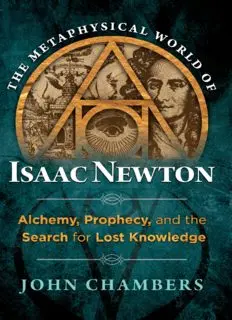
The Metaphysical World of Isaac Newton: Alchemy, Prophecy, and the Search for Lost Knowledge PDF
Preview The Metaphysical World of Isaac Newton: Alchemy, Prophecy, and the Search for Lost Knowledge
To my sister-in-law, Bonnie Balas (1945–2012), who made this book possible, and my wife, Judy, who makes everything possible ACKNOWLEDGMENTS For their help in supplying me with valuable information and/or invaluable moral support, I would particularly like to thank the following: Arthur Davis, Roger Doyle, Martin Ebon, Terry Helbick, Brian Johnston, Cat Karell, Guyon Neutze, Henry Roper, Robert Ryan, Steven Sittenreich, and, of course, J.C. CONTENTS Cover Image Title Page Dedication Acknowledgments CHAPTER ONE: “A History of the Corruption of the Soul of Man” CHAPTER TWO: The Newton Code CHAPTER THREE: Newton’s God CHAPTER FOUR: Bloodbath in a Boghouse: Murder in the Fourth Century AD, Part 1 CHAPTER FIVE: The Severed Hand: Murder in the Fourth Century AD, Part 2 CHAPTER SIX: The Temptation of Saint Anthony CHAPTER SEVEN: The Great Apostasy CHAPTER EIGHT: Apocalypse 2060? CHAPTER NINE: The Conversion of the Jews CHAPTER TEN: With Noah on the Mountaintop CHAPTER ELEVEN: In the Days of the Comet CHAPTER TWELVE: Deconstructing Time CHAPTER THIRTEEN: Chiron and the Star Globe CHAPTER FOURTEEN: A Glitter of Atlantis CHAPTER FIFTEEN: The Secret of Life CHAPTER SIXTEEN: Masters of the Prisca Sapientia, Part 1: Aristarchus, Anaxagoras, Numa Pompilius CHAPTER SEVENTEEN: Masters of the Prisca Sapientia, Part 2: Philolaus, Pythagoras, Moses, Pauli CHAPTER EIGHTEEN: Son of Archimedes APPENDIX A. Newton’s Prophetic Hieroglyphs APPENDIX B. Further Corruptions Found in the New Testament APPENDIX C. Newton’s Twenty-Three Queries Concerning the Word ὁμοούσιος APPENDIX D. Newton on God’s Anti-Trinitarian Introduction to John’s Book of Revelation APPENDIX E. Newton on Ancient Science APPENDIX F. Newton’s Translation of the Emerald Tablet Footnotes Endnotes Bibliography About the Author About Inner Traditions • Bear & Company Books of Related Interest Copyright & Permissions Index CHAPTER ONE “A HISTORY OF THE CORRUPTION OF THE SOUL OF MAN” Epitaph Intended for Sir Isaac Newton In Westminster Abbey ISAACUS NEWTONIUS: Quem Immortalem Testantur, Tempus, Natura, Coelum: Mortalem Hoc marmor fatetur.*1 Nature and Nature’s Laws lay hid in Night: GOD said, Let Newton be! and all was light. ALEXANDER POPE, 1730 Not long after the publication in 1687 of Isaac Newton’s Principia Mathematica (Principles of Mathematics), the great work of science that completely changed the way we perceive the world around us, the Marquis de l’Hôpital, a prominent French mathematician, was shown a copy. He read a little, then “cried out with admiration, ‘Good god, what a fund of knowledge there is in that book!’ He then asked the Doctor [who had shown him the book] every particular about Sir Isaac, even to the color of his hair, [and] said, ‘Does he eat and drink and sleep? Is he like other men?’”1 Edmund Halley, the comet-chasing astronomer who edited the Principia, added to the book an ode that ended with the line “Nearer the Gods no mortal may approach.” When he presented Queen Anne with a copy, Halley told her: “All science can be divided into two halves. The first is everything up to Newton. The second is Newton. And Newton had the better half.”2 The French philosopher Voltaire declared: “Before Kepler, all men were blind. Kepler had one eye; Newton had two.”3 It has been almost three hundred years since Isaac Newton died, and he is still regarded by the world—Albert Einstein and Stephen Hawking affirmed this view—as the greatest scientist who ever lived. His achievements are astonishing, and, if we tend to forget this, it is only because they have become the background noise of the world in which we live. His mathematical physics have, in the words of physicist Hermann Bondi, “entered the marrow of what we know without knowing how we know it.”4 The world from which Newton departed in 1727 was substantially different from the world into which he was born, and he himself accounted for much of the difference. Ninety percent of the physics and math we learn in high school comes from Isaac Newton. He invented calculus, discovered the binomial theorem, introduced polar coordinates, proved that white light was a mixture of colors, explained the rainbow, was the first to build a reflecting telescope, and demonstrated that one force, that of gravity, is responsible for pulling objects to the ground, guiding every celestial body in its orbit, and generating the tides. These are only the main headings of Newton’s work, which first broke upon a totally unprepared public in the Principia Mathematica of 1687. Innumerable individual discoveries and penetrating observations flow from these overarching categories. The Principia is universally considered to be the greatest work of science ever written. Newton published an adjunct work, On Optics, in 1702. It is considered to illustrate in exemplary fashion how to write a science textbook. But these epochal texts are only one-half of Newton’s literary achievement. We know today that he spent almost his entire life writing a whole other book. This work consists of many separate but interlocked parts. If we were to give it a single title, it might be “History of the Corruption of the Soul of Man.” It is five million words long—perhaps the minimum number of words required to cover the all-encompassing subject of mankind’s troubled relationship to goodness and God. This “History” consists of hundreds of glittering treatises and fragments of treatises on alchemy, chronology, mythology, the history of Christianity, the interpretation of biblical prophecy, and much more. We find in it none of the astonishingly brave and astute overturning of paradigms that characterize the
